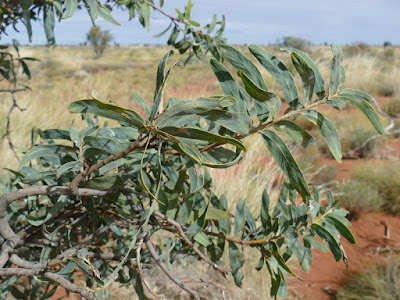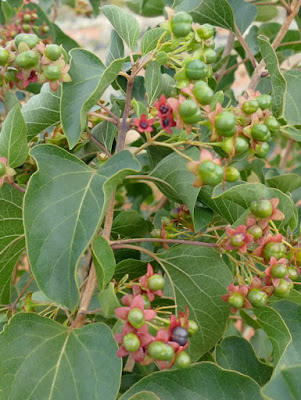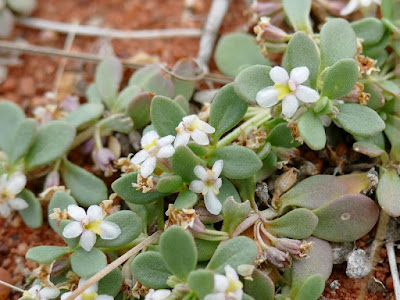This was to be the last in this series based on my recent experiences in the remote and relatively little-known Great Sandy Desert of Western Australia (which began here) but I've realised that I've got quite a large number of plant photos - I was there in a rare good season, when a lot of plants were flowering after substantial rains. I could of course just make a limited selection, which is what I'd probably do normally, but because few of my readers will probably have an opportunity to go there, and most of the plants will thus be unfamiliar, I've decided to introduce them pretty comprehensively, in two postings. In deference to those with less interest in the topic I'll take a break from the series next week, and talk about something entirely different, before coming back to finish by talking about some desert shrubs in a fortnight.
(And before going on, if you read the last posting, on animals of the desert, you might be interested in looking at the unexpected solution to the mysterious mud pellets surrounding the burrows in the salt of Lake Mackay!)
(And before going on, if you read the last posting, on animals of the desert, you might be interested in looking at the unexpected solution to the mysterious mud pellets surrounding the burrows in the salt of Lake Mackay!)
In the first posting, while introducing the landscape, I featured some key trees that help define in it various places - Mulga, Desert Oak, Desert Paperbark, Ghost Gums and Desert Bloodwoods. I won't revisit them today, but there were other trees, mostly low-growing, which appeared from time to time. There were quite a few acacias, as there are pretty much anywhere in Australia, but most were shrubs which will have their moment next time, but in addition to the Mulga, a couple of acacia trees occurred fairly frequently, though generally growing alone.
 |
| Black Gidgee Acacia pruinocarpa is a striking desert tree, whose distribution is centred on the Great Sandy Desert. |
 |
| The distinctive large leathery foliage of Black Gidgee. |
 |
| A small clump of Wirewood growing on a spinifex plain. |
 |
| Wirewood foliage and flowers; central desert people eat the seeds whole, and as flour. |
 |
| Whitewood is an excellent shade tree in country where shade is in short supply; I remember some good camps in its shelter. |
 |
| Desert Poplar Codonocarpus cotonifolius Family Gyrostemonaceae is more familiar in southern arid lands, though there are also outliers to the west of the Great Sandy. |
 |
| Eucalyptus (or Corymbia) deserticola - ie 'desert dwelling' - is found scattered across the more northern deserts of Western Australia and the Northern Territory. |
 |
| The distinctive fruit and leaves of E. deserticola. Like some other eucalypts, it retains its juvenile leaves, which are opposite and clasp around the stem. |
I've introduced the Proteaceous genus Hakea before in an earlier blog; a couple of species thrive in the arid sandiness of the central deserts.
 |
| Fork-leaved Corkwood Hakea divaricata, above and below. Another central desert specialist. |
 |
| Corkwood Hakea lorea, above and below. The corkiness of the bark (not really the wood) is evident above. |
 |
| Goodenia centralis, as the name suggests, of the central (and western) deserts. |
 |
| This Goodenia, above and below, I can't find in any of my books. Advice welcomed! |
 |
| Again my thanks to Bevan (comments below) for solving this mystery. It's one I'd never heard of, a Peplidium sp., family Phrymaceae (likewise!). |
But it's probably best for my self-esteem to end with a couple that I am reasonably confident about!
 |
| A samphire, Tecticornia verrucosa. It is apparently a source of edible seeds prized by desert Aboriginal people. |
BACK
ON THURSDAY
(And remember that you can get a reminder when the next post appears by putting your
email address in the Follow by Email box in the top right of this screen.)
(And remember that you can get a reminder when the next post appears by putting your
email address in the Follow by Email box in the top right of this screen.)














8 comments:
Ian
The Calandrenia stagnensis comes from the latin "stagnalis" pooler swamp so the name refers to growing in swampy areas I presume. The ground hugging plant with the lovely flowers is a genus called Peplidium. Im not sure what the plant above it is but a guess would be Macgregoria racemigera or Desert Snow. The Botany team collected many Goodenias, including the ones you presented, and we are waiting on the IDs to see if anything is new to science. Thanks for the lovely series on the DD trip. Cheers
First mystery plant -- Isotoma? maybe I. luticola? A guess based on the fact that the flowers look like Isotoma, and I. luticola occurs in the GSD.
It was great to read the explanation of the 'excavations' in the previous post, and I see you have an alternative species for the pyrgomorph. All good stuff.
The ID for the first mystery plant by Bevan Buirchell looks better (and he sounds considerably more expert on the subject than me :-)). I just looked at some pics of Macgregoria racemigera. I can't find a pic of Isotoma luticola. We must have been typing simultaneously.
I thought it was an Isotope at first glance as the flower shape is typical but most Isotopes that i know have blue petals, including I. luticola. Only one sighting of this plant in WA
Don't you love spell correction - it can't cope with biological names!!
Thanks Ian. Another interesting blog. I was fascinated to see the Brunonia growing there! What a range of climates it can thrive in. And I liked the solution to the mystery salt lake holes you mentioned last time.
Can you foreshadow the definition of "shrub" or would you prefer to leave that to the next epistle?
WRT to the explanation of the rings it is very interesting. Am I correct in inferring that as the projectile material is in a ring all the particles therein are similar in size?
Well, this is a wealth of information and helpful suggestions - thank you all! I'm cautiously going with the Macgregoria, not least because I know of Bevan's expertise in this area, but I confess that I too had thought of Isotoma Susan, but couldn't find a candidate. I should have thought of the Desert Snow, though I'm more used to seeing it covered in masses of flowers. I shall correct where appropriate now.
Yes, I liked the explanation of the rings too, not least because it would never have occurred to me. The particles were of similar size Martin, though I didn't do a very convincing survey.
Finally Bevan, that explanation of stagnalis occurred to me, but it's pretty unusual usage - '-ensis' usually goes on the end of a place name. I'd have expected it to be more like 'stagnalicola' - dwelling in a stagnant place. I'm sure you're right though.
Post a Comment